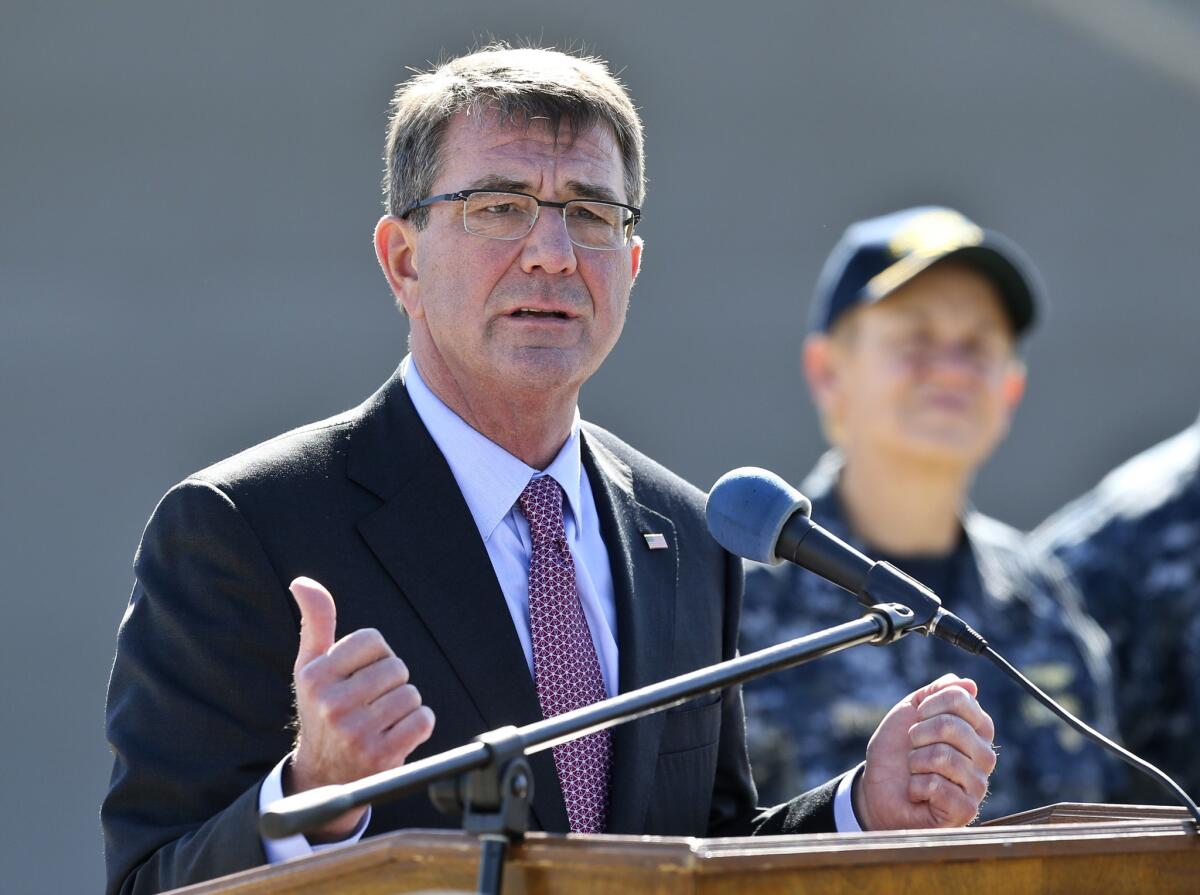Pentagon seeks to boost defense in Europe to counter Russia

Secretary of Defense Ashton Carter answers questions while talking with Navy personnel during a visit to the San Diego Naval Base on Wednesday.
- Share via
Reporting from Washington — The Obama administration wants to enlarge the U.S. military presence in eastern and central Europe next year by stockpiling heavy weapons, armored vehicles and other military equipment across the region, a substantial expansion of U.S. efforts to counter a resurgent Russia.
The proposed $3.4-billion initiative will permit the Pentagon to keep the equivalent of a 4,000-soldier armored brigade in the region at all times on rotational deployments, though no troops will be formally based there, officials said.
“We asked for the amount we think we’ll need” to counter “the Russian challenge in Europe,” Defense Secretary Ashton Carter told reporters Wednesday during a visit to a naval weapons research facility in China Lake, north of Los Angeles.
See more of our top stories on Facebook >>
The proposal, part of the Pentagon’s $583-billion budget request, must be approved by Congress. The administration is expected to unveil the budget next week.
The administration also plans to double spending for the battle against Islamic State. American aircraft have conducted so many airstrikes in Iraq and Syria since mid-2014 that the Pentagon is running out of smart bombs and missiles; it will seek $1.8 billion next year to buy 45,000 more.
But in a speech Tuesday, Carter listed Russia as the primary threat to U.S. interests, citing President Vladimir Putin’s annexation of Crimea and military operations in eastern Ukraine that potentially threaten the Baltic nations.
“We’re reinforcing our posture in Europe to support our NATO allies in the face of Russia’s aggression,” Carter told the Economic Club of Washington. “We haven’t had to worry about this for 35 years, and while I wish it were otherwise, now we do.”
The Pentagon plans to construct or refurbish maintenance facilities, airfields and training ranges in seven European countries: Bulgaria, Estonia, Germany, Latvia, Lithuania, Poland and Romania. All are members of the NATO alliance.
Except for Germany, all were under Soviet domination during the Cold War. Germany was divided into two countries, one pro-West and the other aligned with Moscow.
Many of the seven have pressed NATO and the U.S. for a greater presence since Russian forces seized Crimea in 2014 and began backing pro-Russian separatists in Ukraine with weapons and troops.
Russia has boosted defense spending dramatically over the last decade to modernize its military. It has used some of the new weapons, including ship-launched cruise missiles, to support its intervention in Syria on behalf of the country’s embattled president, Bashar Assad.
Pentagon officials, who spoke on condition of anonymity to discuss parts of the plan that have not been made public, conceded that several thousand U.S. troops spread across seven countries could not hold back the Russian Army should it decide to invade.
The expanded U.S. presence is meant to signal Moscow that the U.S. would come to the aid of its allies with additional forces in case of war and to reassure allies of American backing, the officials said.
It would take at least seven NATO brigades, including three with tanks and other armored vehicles, backed by artillery and combat aircraft, to prevent Russian forces from “the rapid overrun” of Latvia, Lithuania and Estonia, according to a study released this week by Rand Corp., a Santa Monica-based policy analysis organization.
Russian forces could reach Estonia and Latvia’s capital cities in less than 60 hours, the study estimated.
“Such a rapid defeat would leave NATO with limited options, all bad, “ the study said, noting that putting seven brigades in the region “while not enough to mount a sustained defense ... would fundamentally change the strategic picture as seen from Moscow.”
Estonia is the only NATO member other than the United States that last year spent at least 2% of its gross domestic product on defense, NATO said last month.
None of the money requested by the White House is earmarked for Ukraine, which is not in NATO.
The Pentagon has sent troops to train with Ukraine’s armed forces and provided the government in Kiev with nonlethal equipment. But the administration has stressed it does not plan to go to war in Ukraine, and is relying on economic sanctions and diplomatic pressure to deter Russia from further involvement.
In a 1997 agreement meant to prevent a return to Cold War tensions, NATO and Moscow pledged not to station large numbers of forces on each other’s borders.
Pentagon officials say the proposed expansion does not violate that pledge because the troops will rotate in and out to multiple locations, even though the effect will be a constant presence.
During the Cold War, U.S. European Command stationed more than 200,000 U.S. troops in Germany and other NATO countries. It now has about 65,000 troops, including two combat brigades of about 3,500 soldiers each.
The Army has designated a brigade based at Fort Stewart, Ga., parts of which will rotate to Europe every year. But the forces envisioned for eastern and central Europe will come from other Army units, the officials said.
ALSO
A boy’s life in Afghanistan: Anti-Taliban fighter at 9, dead at 12
Signing of Trans-Pacific Partnership trade deal opens up tough battle in U.S.
Each side in Syria peace talks blames the other for causing ‘temporary pause’
More to Read
Sign up for Essential California
The most important California stories and recommendations in your inbox every morning.
You may occasionally receive promotional content from the Los Angeles Times.











